Written by: Ignas | DeFi Research
Translated by: Yangz, Techub News
A year ago, I co-founded the DeFi studio Pink Brains with my high school classmate Arthur. Currently, the team consists of six members, four of whom are from Vietnam. During our collaboration, we clearly recognized the significant differences between the cryptocurrency market and the mindset of local investors in Vietnam compared to the West.

Cryptocurrency has evolved into a global industry, and the dominance of Western and English KOLs may lead us to overlook opportunities outside the West.
For instance, in my previous blog post on the "Current State of the Market," I was surprised to find that although OpenSocial is less popular on X compared to Farcaster and Lens, it surpasses the latter in terms of user numbers. Its success lies in its large user base from Indonesia, Vietnam, and India.
Therefore, in this blog post, I, along with Mai, the behind-the-scenes force of Pink Brains' official X account, will share insights into the cryptocurrency markets of South Asia and Southeast Asia. We also interviewed several investors from these regions to learn about their personal experiences.
South Asia: An Untapped Wilderness in the Cryptocurrency Industry
The TOKEN2049 Singapore Summit is the largest cryptocurrency event of 2024, and a statement from Andy caught our attention: "The Asian market is still untapped."
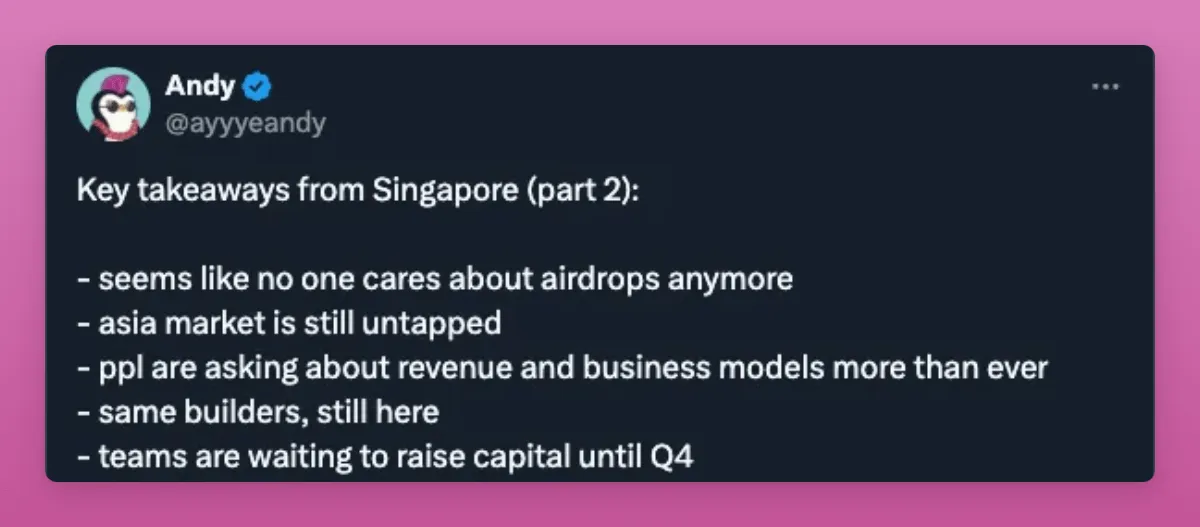
East Asia has become a mainstream cryptocurrency hub, with clear regulations and participation from large institutions and professional investors, while Central Asia, South Asia, and Oceania (CSAO) have adopted a different, often overlooked approach to cryptocurrency adoption.
The following image is the global cryptocurrency adoption index map drawn by Chainalysis for 2024.
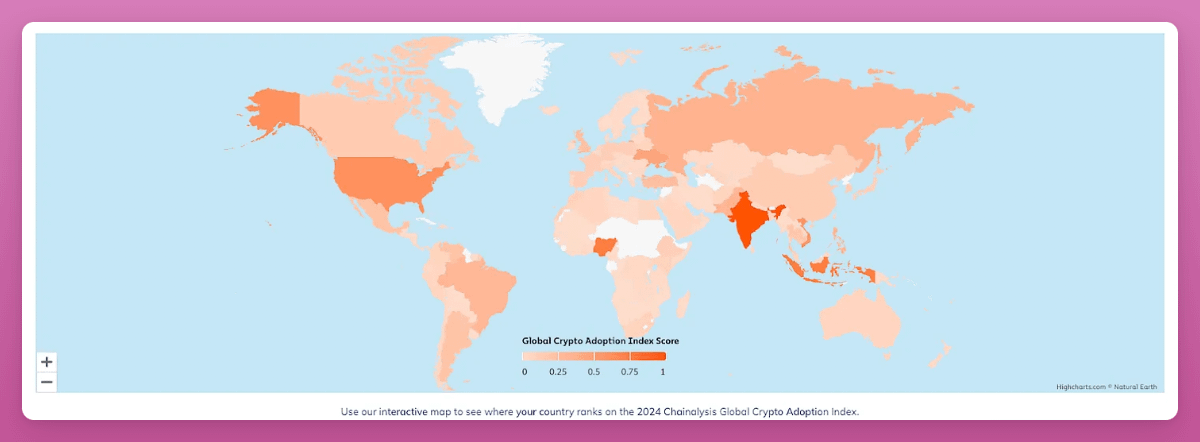
Chainalysis data shows that the CSAO region is the third-largest cryptocurrency market, with over $750 billion in cryptocurrency inflows from July 2023 to June 2024, accounting for 16.6% of the global total, second only to North America and Western Europe.
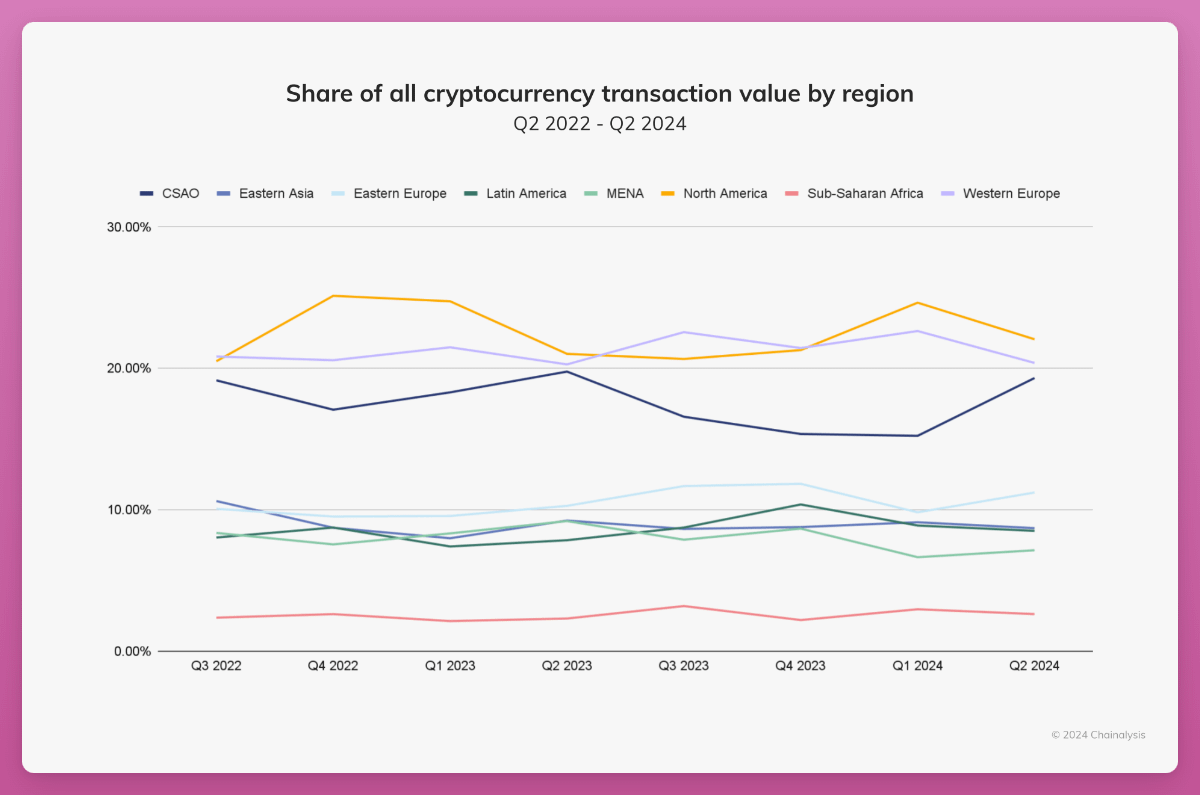
Moreover, among the top 20 countries in the global cryptocurrency adoption index for 2024, seven are from this region, including India (ranked 1st), Indonesia (ranked 3rd), Vietnam (ranked 5th), the Philippines (ranked 8th), Pakistan (ranked 9th), Thailand (ranked 16th), and Cambodia (ranked 17th).
By the way, last year I shared my personal insights on why Koreans are enthusiastic about cryptocurrency but not keen on DeFi in my article. I lived in Korea for eight years, and interested readers can learn about the cryptocurrency culture in Korea._
How South Asian and Southeast Asian Investors Adopt Cryptocurrency
Vietnam
Let's start with Vietnam. As mentioned at the beginning of the article, most of our team members at Pink Brains are from Vietnam, and they have firsthand experience of the Vietnamese market.
According to data from Triple-A, Vietnam has the second-highest cryptocurrency ownership rate. Approximately 21.2% of the population holds cryptocurrency, second only to the UAE's 34.4%.
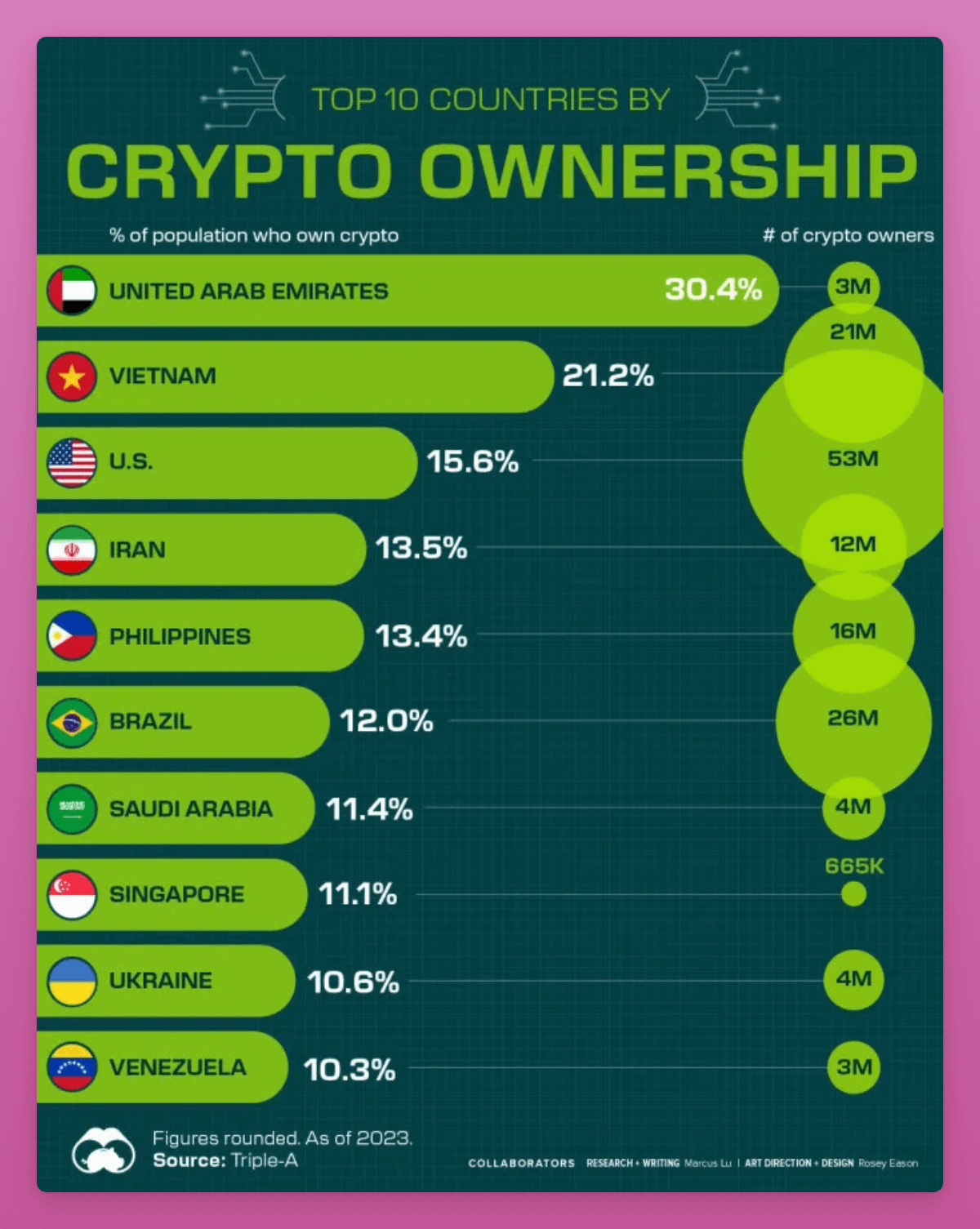
Additionally, Chainalysis data shows that Vietnamese investors made significant profits last year, with $1.18 billion in cryptocurrency realized gains, ranking third globally, double that of investors in Spain and the Philippines, and three times that of investors in Thailand.
The reason behind this is the Vietnamese government's ambiguous stance on cryptocurrency. While using cryptocurrency for payments or collateral in real-life applications is not permitted, the government has not completely banned cryptocurrency. Therefore, holding cryptocurrency poses an attractive risk exposure for investors in the country, even though the actual adoption rate still lags behind other Southeast Asian countries.
For most Vietnamese cryptocurrency investors, centralized exchanges (CEX) are the preferred choice. Among them, Binance, Bybit, OKX, and BingX are the most popular, while Coinbase has a small market share due to language barriers and complex KYC processes. Trading and holding cryptocurrency on exchanges remain the most common investment strategies locally.
Additionally, airdrops and cryptocurrency mining are also popular investment trends in the country. Numerous Telegram and Facebook groups share various mining tips, potential "treasure" opportunities, and hold various token giveaway events. In fact, purchasing clone accounts, faking KYC, or setting up bots is very easy and inexpensive in the region. This has made sybil attacks from Vietnamese investors a real challenge faced by many protocols. Some major airdrops, including Arbitrum, LayerZero, Aptos, and Zksync, have seen the involvement of Vietnamese investor witch attacks.
However, most investors in Vietnam lack experience. They primarily seek quick returns, viewing cryptocurrency as a side hustle or a life-changing opportunity outside their main jobs. Seasoned investors in the region often look for low market cap tokens on DEXs while holding most of their assets on CEXs. New investors entering the industry after 2022 often chase airdrops. Experienced traders typically suffer losses during significant black swan events like FTX or Luna, while newcomers are often hurt by poor KOL signals, scams, or excessive leverage.
Furthermore, as a top country in international mathematics competitions, Vietnam is also a hub for blockchain development talent. You may have heard of prominent figures like Loi Luu (Kyber Network) and Vu Nguyen (Pendle), but there are also some notorious scammers from Vietnam, such as the masterminds behind Whale Markets!

Mai also told me that retail banking and cashless payments in Vietnam are developing rapidly.
Vietnam is following a path similar to that of China, especially in major cities, where digital wallets, banking apps, and credit cards are slowly replacing cash. This shift is a significant boon for Web3, as it creates conditions for cryptocurrency payments, similar to what is happening in Singapore.
Moreover, an increasing number of large companies are beginning to integrate blockchain into their business operations. We have already seen small-scale tests in the banking sector, such as the first blockchain experiment for letter of credit payments by HSBC Vietnam.
These efforts indicate that Vietnamese enterprises are closely monitoring blockchain. However, for now, everything still awaits a more open legal framework for cryptocurrency in the country.
India
Despite changing regulations and taxes, India remains a major player in the global cryptocurrency market. As is well known, India imposes a high tax of 30% on cryptocurrency gains and a 1% tax on all transactions, leading some investors to seek less restricted international exchanges for investment.
However, despite these obstacles, the development of cryptocurrency in India is still rapid. The rise of innovative cryptocurrency startups in India indicates that the country needs more favorable tax policies and clearer regulations to maintain its growth momentum.

I asked Hitesh.eth on X about what makes India special. Hitesh.eth stated that India has a large population of unemployed youth eager for incentives. Therefore, if executed properly, cryptocurrency applications can be guided in the form of tokens and points, similar to what we saw with Axie in the past. Additionally, in terms of infrastructure, India has some of the best developer resources, and costs are much lower than in the EU and the US. He said, "Over 50% of community-related work is done by Indians, and there are even more young people eager to join this field."
However, this gig nature and strong ambition have also "led to some issues, as seen in some past airdrops, where there is a misconception about Indians in the industry. However, this view is not representative, as it is more situation-specific."
Indonesia
In terms of trading volume, Indonesia is one of the fastest-growing markets.
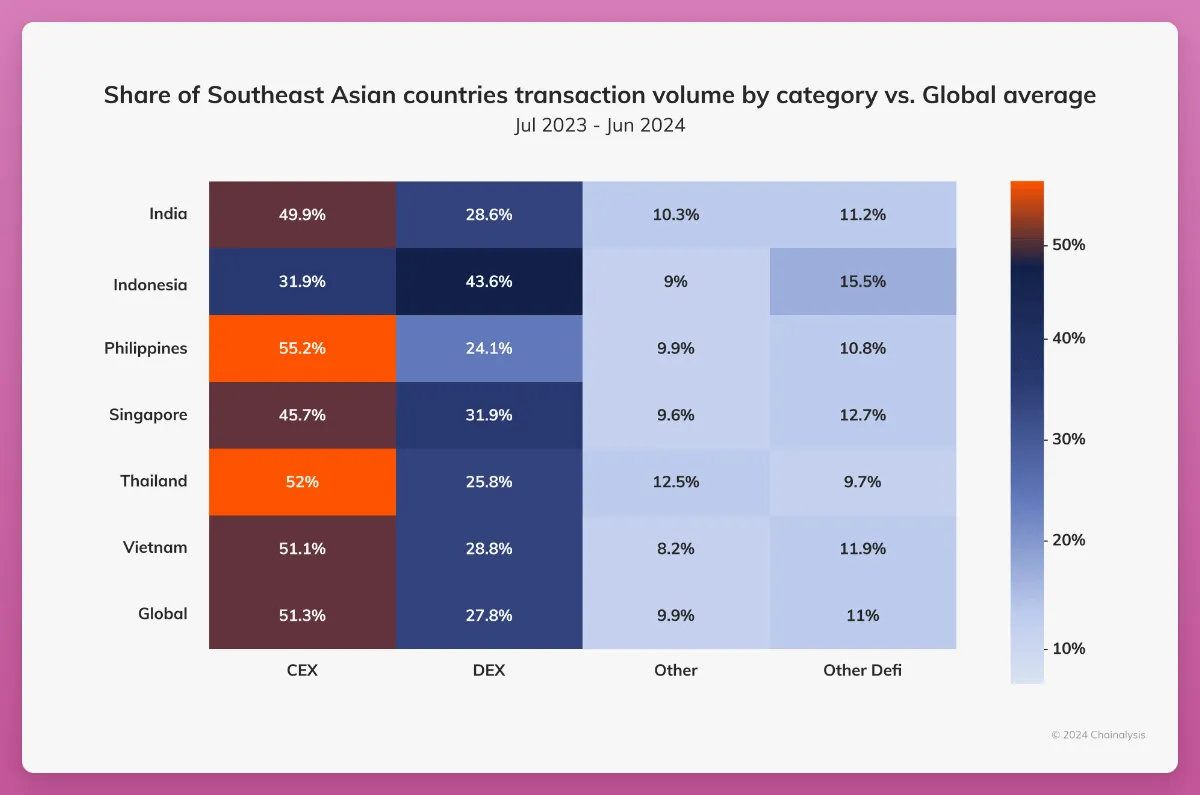
The product manager of the Indonesian cryptocurrency exchange Pintu stated that the rise of cryptocurrency activity in the country is primarily driven by speculation. "Many people still see cryptocurrency as a way to make quick profits," he said. "Now, many traders turn to Telegram groups for signals, just like they used to when trading stocks, but the activity in cryptocurrency is more intense because new tokens keep emerging."
He also mentioned that the stricter rules of the Indonesian stock exchange might push people towards cryptocurrency. "As new comprehensive auction measures make stock trading more regulated, some investors are looking for alternatives like cryptocurrency."
Additionally, compared to regional and global averages, Indonesia is leading in DEX and DeFi activity.
Eli5DeFi confirmed this, stating, "Many Indonesians participate in cryptocurrency, usually starting with memecoins or airdrops because they are simpler and more exciting. Especially airdrops, which often only require time and effort to participate." He added, "We are currently focusing on TON applications, and some people even build communities to farm DOGS, NOT, and HAMSTER."
As Indonesians become more proficient in cryptocurrency, liquidity mining, staking, and DeFi projects are becoming increasingly popular locally. This growth has created a new generation of "crypto degen" communities, with millennials and Gen Z making up more than half of the investor demographic, seeking emerging technologies and quick profits.
Moreover, DeFi is also on the rise, with Eli5DeFi noting that there are many DeFi builders in Indonesia, such as Monad co-founder @0x_eunice, Pyth co-founder @Mariobern, HawkFi CTO @bradydonut, and Pandora's @mathdroid.
Singapore
In countries like Indonesia and Vietnam, cryptocurrency adoption is driven by "Crypto Degens" and promises of quick returns, while the situation in Singapore is somewhat different.
Ronald Chan from Saprolings (a Web3 incubator) stated that after China issued related bans, a large number of cryptocurrency companies flocked to Singapore. The reasons they chose Singapore include:
Proximity to China
Strong Chinese cultural influence
Loose regulatory policies
Low tax rates
Large Chinese-speaking population
Free flow of capital (including Bitcoin)
Strong rule of law (this is very important)
Well-educated business professionals
The region's status as a financial hub
No other alternative advantages in the region
Ronald Chan stated that regulatory advancements and merchant services highlight the broader potential of cryptocurrency beyond trading and investment. He noted that Singapore "issues banking licenses to local and foreign banks, allowing them to compete on equal footing, which is different from many other countries." Additionally, Singapore "has a nationwide QR scanning system that is very similar to China's Alipay and WeChat Pay. This system supports Mastercard and Visa, but users and merchants do not prefer it because both parties have to pay extra fees."
Furthermore, the country's super app Grab, used for ride-hailing, food delivery, and other services, has also begun allowing users to top up their e-wallets with cryptocurrency. Currently, supported cryptocurrencies include Bitcoin, Ethereum, XSGD (Singapore's local stablecoin), USDC, and USDT.
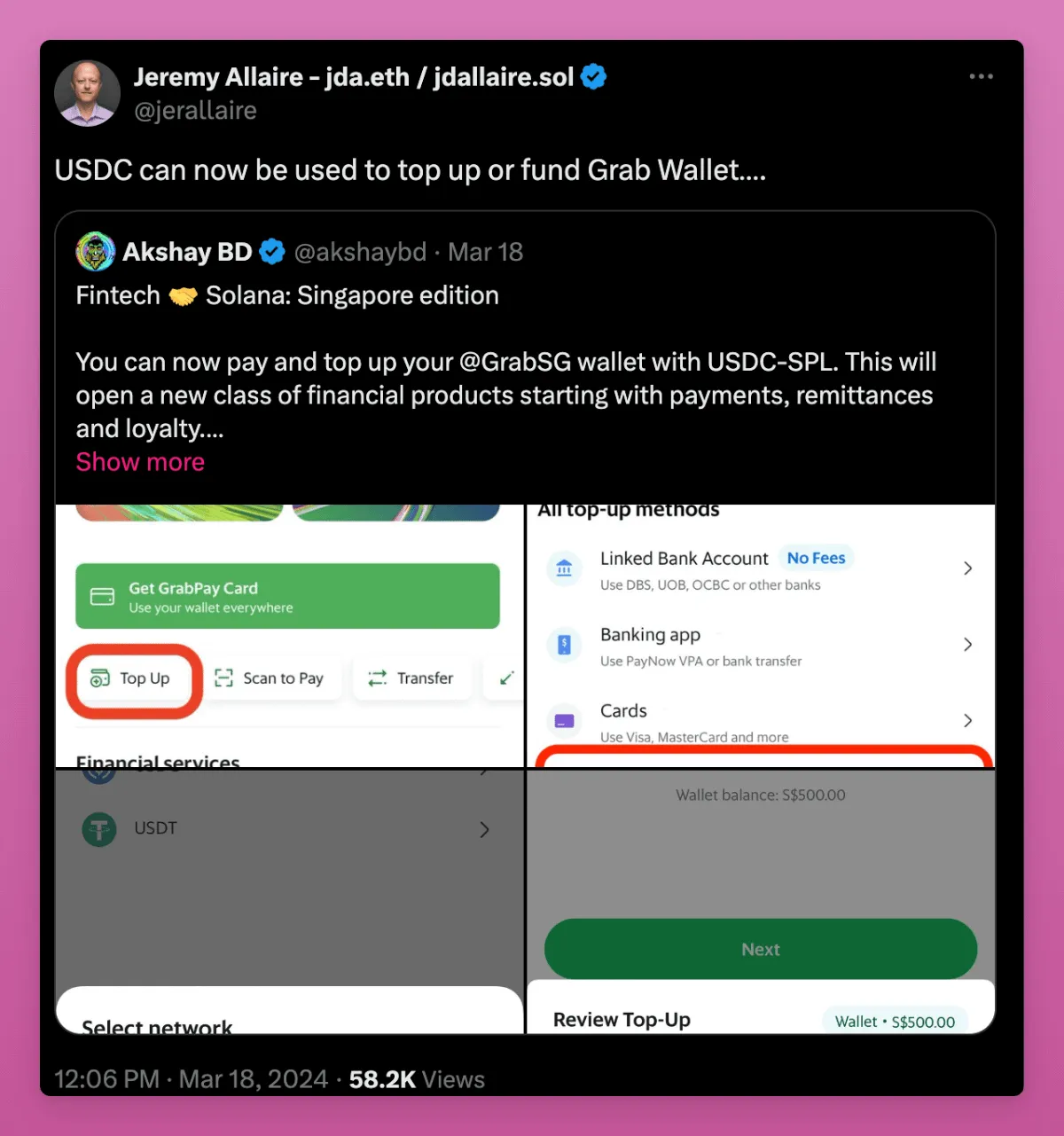
In the second quarter of 2024, cryptocurrency payments in Singapore's merchant services reached nearly $1 billion, the highest level in two years. This is an interesting shift for a market where traditional payment systems are already very efficient, indicating that cryptocurrency is becoming a common asset for more people. At the same time, over 75% of XSGD transfer amounts are $1 million or below, with nearly 25% of the amounts being under $10,000, suggesting that the retail user base in the local cryptocurrency space is continuously expanding.
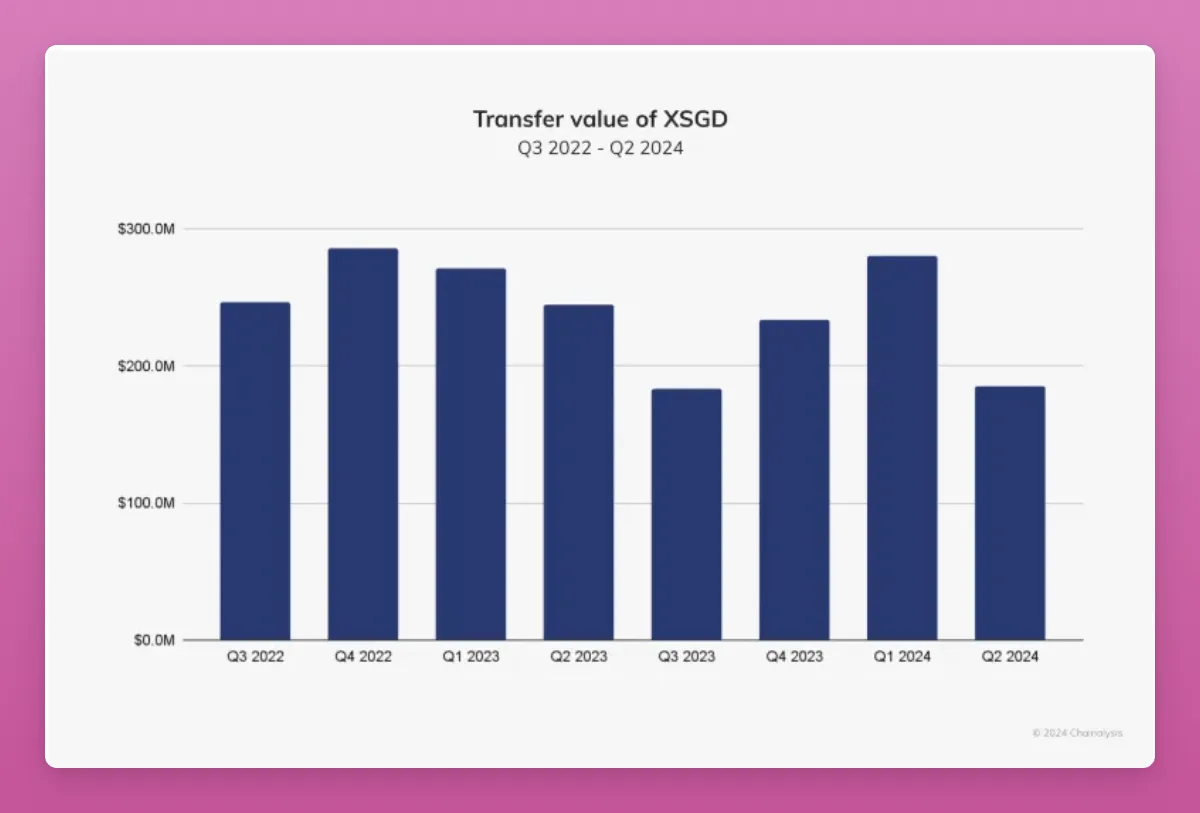
The success of Singapore lies in its clear regulatory policies, which have increased trust in stablecoins. In 2023, the Monetary Authority of Singapore (MAS) established guidelines for stablecoins, and the following year, the agency introduced rules for cryptocurrency custody and licensing.
Singapore's success serves as an example for the U.S. to promote adoption through clear regulatory policies.
Case Study: TON's Successful Entry into the South Asian Market
The TON ecosystem's play-to-earn games are extremely popular in South Asia. I have tried a few, but personally, the rewards are not high.
You might look down on TON due to excessive "airdrops" and "mindless" play-to-earn games, but this actually aligns with their goal of putting cryptocurrency into everyone's pockets.
By earning free tokens, a new wave of users is starting to learn how to trade on DEXs, add liquidity, stake, and gradually explore other areas of the Ton ecosystem.
Most of these users come from CIS countries and South Asian nations.
Over 66% of the traffic to the Notcoin website comes from CIS countries, followed by Asian countries like Indonesia, Vietnam, China, and India. Getgems.io and Hamster Kombat also show similar trends, matching the user base on Telegram. Additionally, the situation with Telegram Mini Bots offering free tokens is reminiscent of the rise of Axie Infinity in the Philippines.

TON's success can be attributed to two highly popular areas: free airdrops and play-to-earn games.
Free Airdrops
Everyone is tired of activities that require points to exchange for airdrops. This is where the unique aspect of the Telegram free airdrop scene comes in.
TON ecosystem projects can leverage Telegram's 900 million users to distribute tokens. For example, DOGS started as just a meme, but due to its fair distribution and no pre-sale approach, it gained widespread attention and brought a large number of new users to TON.
Soon, DOGS was listed on major exchanges like Binance. The value of the airdrops received by each wallet ranged from $10 to $60. While this may not seem much to many investors in Western countries, users can farm with multiple accounts. For many in third-world countries, these airdrops provide a new source of income amid economic hardship.
Play-to-Earn Games
Play-to-earn games like Hamster Kombat have rapidly risen in South Asian countries. In just three months, Hamster Kombat reached 239 million user registrations, becoming one of the most popular play-to-earn games. Additionally, its YouTube channel gained over 10 million subscribers in just one week. It's safe to say that these numbers are unprecedented in many Western countries.
Furthermore, Bitget Premarket data shows that the total market capitalization of Hamster Kombat tokens is $920 million, indicating that the airdrop value is approximately $550 million.
Thanks to simple gameplay, referral activities, and positive social effects, play-to-earn games like Hamster Kombat have quickly attracted the attention of cryptocurrency KOLs in Southeast Asia. These KOLs are as popular on TikTok as they are on X.
Conclusion
South Asia and Southeast Asia are among the most populous regions in the world, with a young and tech-friendly demographic, making them key areas for cryptocurrency businesses to focus on, second only to the U.S. and Western Europe.
However, due to differences in income, government regulations, and economic conditions across the various countries in the region, it is challenging for businesses to formulate strategies that suit their specific situations. TON seems to have mastered the approach to the degen market in the region, and the adoption rate of cryptocurrency payments is continuously increasing.
免责声明:本文章仅代表作者个人观点,不代表本平台的立场和观点。本文章仅供信息分享,不构成对任何人的任何投资建议。用户与作者之间的任何争议,与本平台无关。如网页中刊载的文章或图片涉及侵权,请提供相关的权利证明和身份证明发送邮件到support@aicoin.com,本平台相关工作人员将会进行核查。



